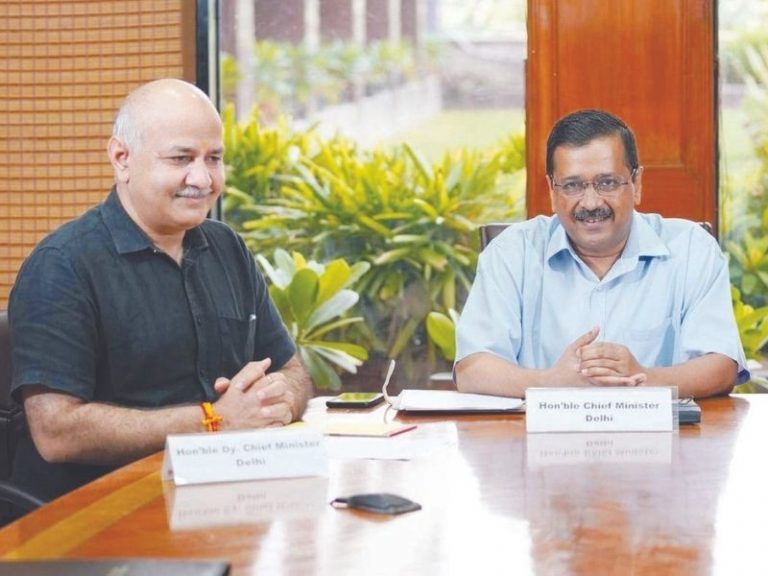No products in the cart.
Delhi: AAP’s education gambit
Autar Nehru (Delhi)

AAP’s chief minister Arvind Kejriwal (right) & education minister Manish Sisodia
The Aam Aadmi Party (AAP), which has ruled Delhi state since 2015 and took on and bested the BJP in the state legislative election of 2020 shortly after the saffron party had swept to power in General Election 2019, is perhaps the sole political formation countrywide that believes provision of high-quality school education is a vote-catching issue. During its six years in office, the AAP government has consistently allocated 20-25 percent of its annual budget to improve, upgrade and enhance the learning outcomes of the 1.5 million children enrolled in its 1,028 state government schools.
It’s pertinent to note that the governance structure of Delhi is confusing and complex. Established as a state of the Indian Union in 1991, it is simultaneously governed by the national, state and two municipal corporations. All these governments run their own schools across the sprawling state (pop. 18 million) which includes the national capital. Thus the total number of K-12 schools in Delhi state is 5,755 with an aggregate enrolment of 4.4 million children.
Nevertheless it’s commonly accepted that the 1,028 state government schools provide the best education of all public schools because as AAP’s election manifesto (2019) proclaims, it sends its school teachers to “coveted institutes in Finland, Singapore and United Kingdom” for training; it has launched special initiatives to improve foundational literacy and numeracy; introduced a unique happiness period and entrepreneurship curriculum and established parents-dominated School Management Committees (SMCs) mandated under s.21 (1) of the RTE Act, 2009. Moreover, the AAP leadership insists that its 22 Rajkiya Pratibha Vikas Vidyalayas (RPVV) — classes VI-XII schools —and five (K-12) Schools of Excellence (estb.2018) whose students write the national CBSE school-leaving exams, are on a par with top-ranked private schools in the national capital with as good board exam results.
The tall claims made by the AAP government to have revolutionised education in state government schools are not mere hype. Two RPVV schools are ranked among India’s Top 5 government schools in the authoritative EducationWorld India School Rankings 2021 with RPVV Sector 10, Dwarka (CBSE average score 90.97 percent) ranked second nationwide.
Having discerned that continuous improvement of teaching-learning standards in public/government schools is a vote catching issue, on March 15 AAP announced its intent to establish 100 model primary-secondary (class VI-XII) Schools of Specialised Excellence (SoSE) which will absorb the state government’s 22 RPVVs and five Schools of Excellence. Out of these 27 schools, 20 have been converted into class IX-XII SoSEs with a “strategic tie-up” with the globally reputed International Baccalaureate (Geneva) examinations board. These 20 secondary schools are ready to receive students when campuses re-open following the current Covid pandemic lockdown. Their number will increase to 100 “in the next few years,” according to government spokespersons.
Unlike normative secondary-higher secondary institutions, SoSEs will admit students who pass its entrance test, into one of five specialised (classes IX-XII) domains — science, technology, engineering and maths (STEM); performing and visual arts; humanities and “high-end 21st century skills”. Partly modelled on the country’s 661 highly successful Jawahar Navodaya Vidyalayas which provide free-of-charge residential education to meritorious rural students, the Delhi state government’s SoSEs will in effect nurture gifted students from socio-economically underprivileged households.
“Thus far the thrust of all policies and initiatives for improving public education has been on inclusion and equity rather than excellence. The AAP government’s SoSE initiative offers meritorious and gifted children from low-income households the opportunity to avail globally benchmarked school education. It is certain to prove very popular,” says Dr. Sudha Acharya, principal, ITL School, Dwarka, Delhi.
In its publicity material and advertising campaigns, its leadership proclaims AAP as a political party “with a difference”. Certainly it deserves full marks for having cottoned on that even households at the bottom of the country’s iniquitous socio-economic pyramid are beginning to appreciate that high-quality education is the sole passport for the upward mobility of their children.
In the Punjab assembly elections scheduled for Feb-March, AAP is set to field a large number of candidates and may well emerge as a major force because of its public education enhancement record in Delhi. That will be an object lesson for the state’s ruling Congress and opposition BJP parties who pay mere lip-service to human capital development.
Also Read:Delhi: Modest new hopes
















Add comment